The Sandy Bridge Review: Intel Core i7-2600K, i5-2500K and Core i3-2100 Tested
by Anand Lal Shimpi on January 3, 2011 12:01 AM ESTGaming Performance
There's simply no better gaming CPU on the market today than Sandy Bridge. The Core i5 2500K and 2600K top the charts regardless of game. If you're building a new gaming box, you'll want a SNB in it.
Our Fallout 3 test is a quick FRAPS runthrough near the beginning of the game. We're running with a GeForce GTX 280 at 1680 x 1050 and medium quality defaults. There's no AA/AF enabled.
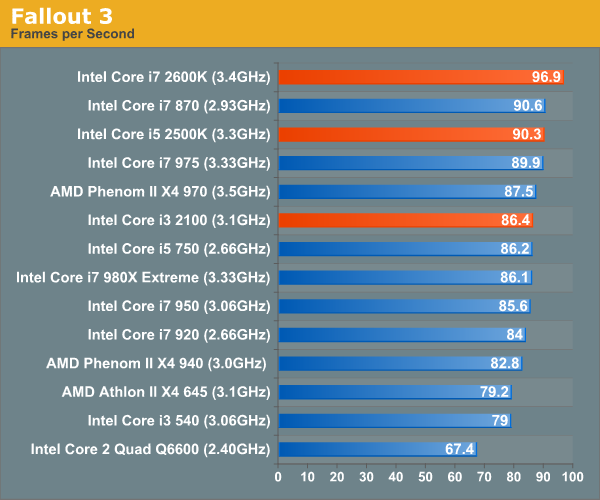
In testing Left 4 Dead we use a custom recorded timedemo. We run on a GeForce GTX 280 at 1680 x 1050 with all quality options set to high. No AA/AF enabled.

Far Cry 2 ships with several built in benchmarks. For this test we use the Playback (Action) demo at 1680 x 1050 in DX9 mode on a GTX 280. The game is set to medium defaults with performance options set to high.
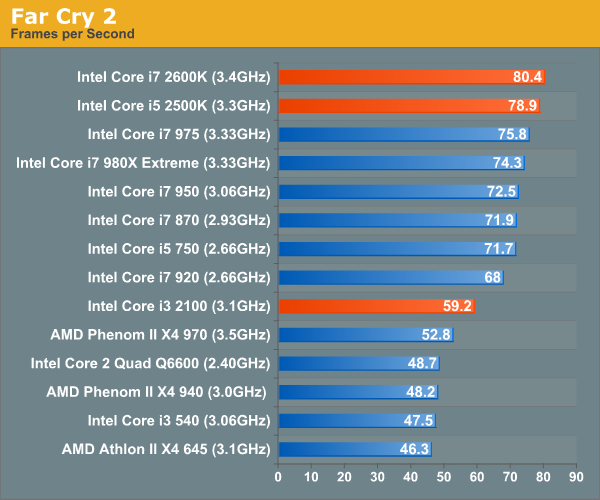
Crysis Warhead also ships with a number of built in benchmarks. Running on a GTX 280 at 1680 x 1050 we run the ambush timedemo with mainstream quality settings. Physics is set to enthusiast however to further stress the CPU.
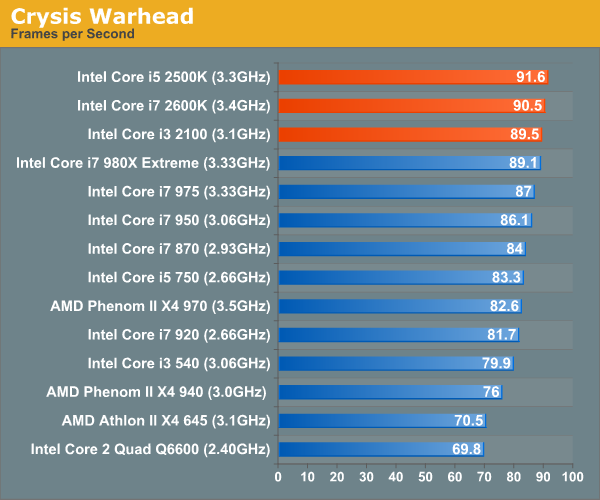
Our Dragon Age: Origins benchmark begins with a shift to the Radeon HD 5870. From this point on these games are run under our Bench refresh testbed under Windows 7 x64. Our benchmark here is the same thing we ran in our integrated graphics tests - a quick FRAPS walkthrough inside a castle. The game is run at 1680 x 1050 at high quality and texture options.
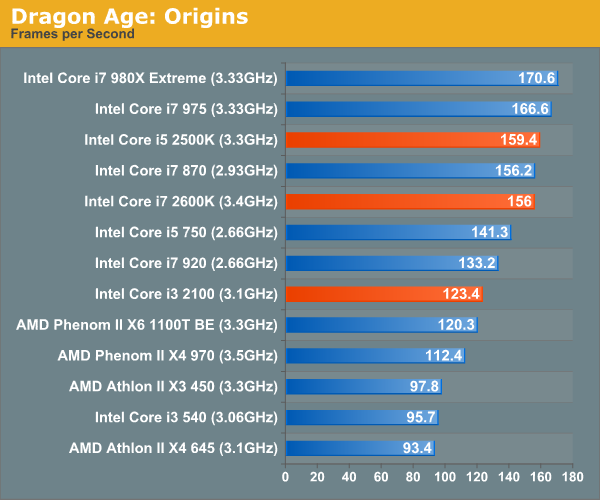
We're running Dawn of War II's internal benchmark at high quality defaults. Our GPU of choice is a Radeon HD 5870 running at 1680 x 1050.
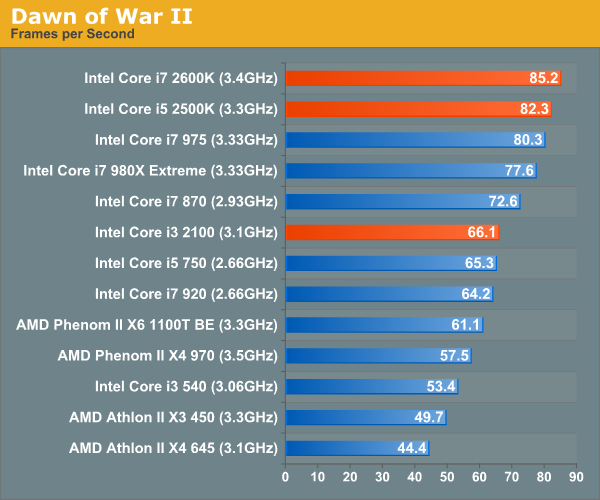
Our World of Warcraft benchmark is a manual FRAPS runthrough of a lightly populated server with no other player controlled characters around. The frame rates here are higher than you'd see in a real world scenario, but the relative comparison between CPUs is accurate.
We run on a Radeon HD 5870 at 1680 x 1050. We're using WoW's high quality defaults but with weather intensity turned down all the way.
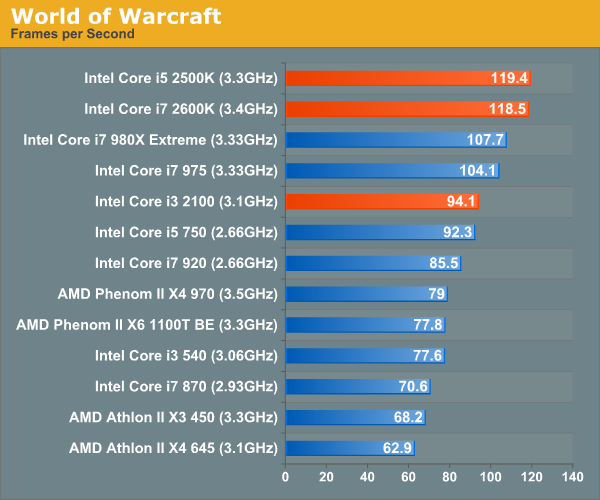
For Starcraft II we're using our heavy CPU test. This is a playback of a 3v3 match where all players gather in the middle of the map for one large, unit-heavy battle. While GPU plays a role here, we're mostly CPU bound. The Radeon HD 5870 is running at 1024 x 768 at medium quality settings to make this an even more pure CPU benchmark.
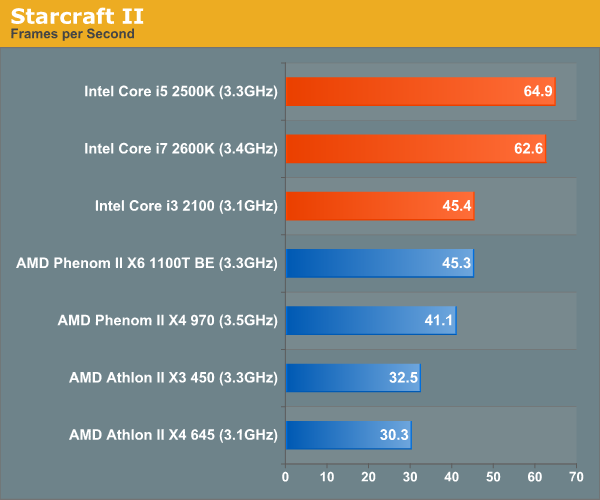
This is Civ V's built in Late GameView benchmark, the newest addition to our gaming test suite. The benchmark outputs three scores: a full render score, a no-shadow render score and a no-render score. We present the first and the last, acting as a GPU and CPU benchmark respectively.
We're running at 1680 x 1050 with all quality settings set to high. For this test we're using a brand new testbed with 8GB of memory and a GeForce GTX 580.
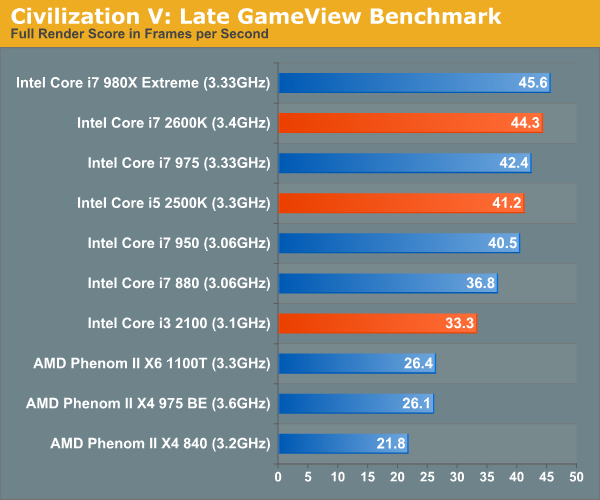
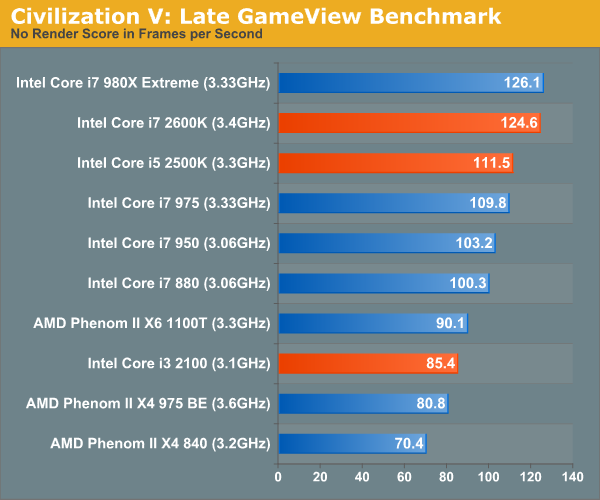










283 Comments
View All Comments
karlostomy - Thursday, January 6, 2011 - link
what the hell is the point of posting gaming scores at resolutions that no one will be playing at?If i am not mistaken, the grahics cards in the test are:
eVGA GeForce GTX 280 (Vista 64)
ATI Radeon HD 5870 (Windows 7)
MSI GeForce GTX 580 (Windows 7)
So then, with a sandybridge processor, these resolutions are irrelevant.
1080p or above should be standard resolution for modern setup reviews.
Why, Anand, have you posted irrelevant resolutions for the hardware tested?
dananski - Thursday, January 6, 2011 - link
Games are usually limited in fps by the level of graphics, so processor speed doesn't make much of a difference unless you turn the graphics detail right down and use an overkill graphics card. As the point of this page was to review the CPU power, it's more representative to use low resolutions so that the CPU is the limiting factor.If you did this set of charts for gaming at 2560x1600 with full AA & max quality, all the processors would be stuck at about the same rate because the graphics card is the limiting factor.
I expect Civ 5 would be an exception to this because it has really counter-intuitive performance.
omelet - Tuesday, January 11, 2011 - link
For almost any game, the resolution will not affect the stress on the CPU. It is no harder for a CPU to play the game at 2560x1600 than it is to play at 1024x768, so to ensure that the benchmark is CPU-limited, low resolutions are chosen.For instance, the i5 2500k gets ~65fps in the Starcraft test, which is run at 1024x768. The i5 2500k would also be capable of ~65fps at 2560x1600, but your graphics card might not be at that resolution.
Since this is a review for a CPU, not for graphics cards, the lower resolution is used, so we know what the limitation is for just the CPU. If you want to know what resolution you can play at, look at graphics card reviews.
Tom - Sunday, January 30, 2011 - link
Which is why the tests have limited real world value. Skewing the tests to maximize the cpu differences makes new cpus look impressive, but it doesn't show the reality that the new cpu isn't needed in the real world for most games.Oyster - Monday, January 3, 2011 - link
Maybe I missed this in the review, Anand, but can you please confirm that SB and SB-E will require quad-channel memory? Additionally, will it be possible to run dual-channel memory on these new motherboards? I guess I want to save money because I already have 8GB of dual-channel RAM :).Thanks for the great review!
CharonPDX - Monday, January 3, 2011 - link
You can confirm it from the photos of it only using two DIMMs in photo.JumpingJack - Monday, January 3, 2011 - link
This has been discussed in great detail. The i7, i3, and i5 2XXX series is dual channel. The rumor mill is abound with SB-E having quad channel, but I don't recall seen anything official from Intel on this point.8steve8 - Monday, January 3, 2011 - link
the K processors have the much better IGP and a variable multiplier, but to use the improved IGP you need an H67 chipset, which doesn't support changing the multiplier?ViRGE - Monday, January 3, 2011 - link
CPU Multiplier: Yes, H67 cannot change the CPU multiplierGPU Multiplier: No, even H67 can change the GPU multiplier
mczak - Monday, January 3, 2011 - link
I wonder why though? Is this just officially? I can't really see a good technical reason why CPU OC would work with P67 but not H67 - it is just turbo going up some more steps after all. Maybe board manufacturers can find a way around that?Or is this not really linked to the chipset but rather if the IGP is enabled (which after all also is linked to turbo)?